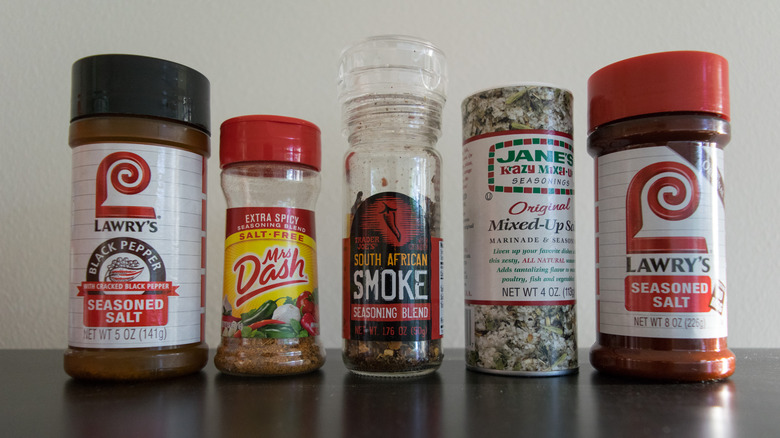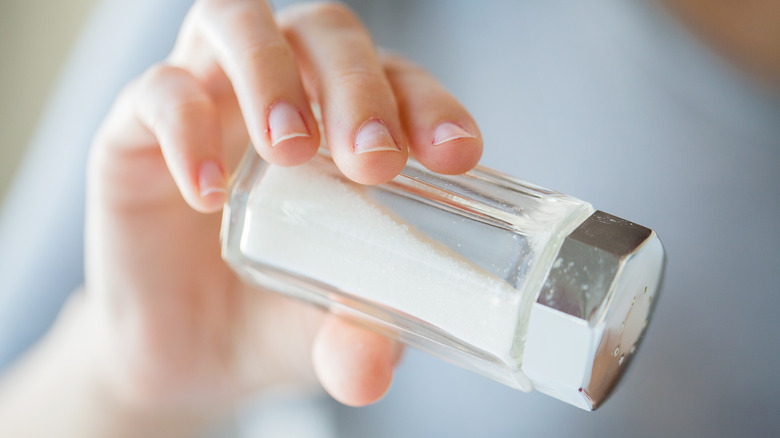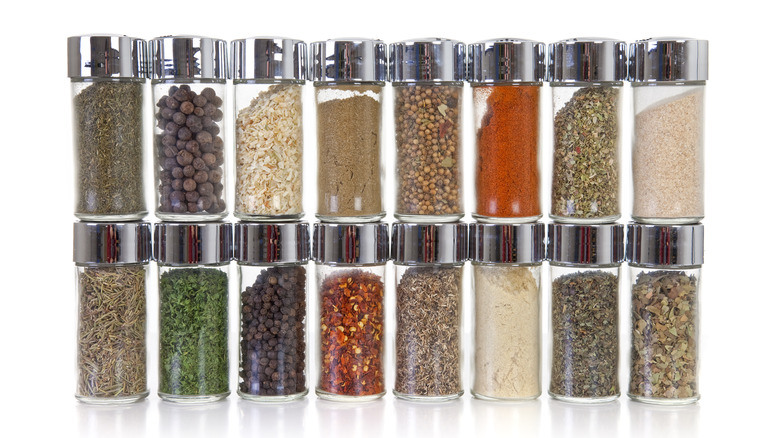Free Your Spice Jars And Remove Those Useless Plastic Sifters
One of the most important components of any kitchen is the spice rack. Maintaining a well-stocked selection of seasonings will not only make a difference in your cooking, but you'll always have exactly what you need, be it bay leaves or nutmeg. The trouble is, most people don't spend a lot of time organizing and updating their spice collection, and it shows. No, the spice police aren't going to come by the house and issue you a warning for an unruly spice drawer. You will, however, waste a lot of time and under-season.
If you want to cook like a chef, there are a few easy steps to streamline your seasonings, starting with the shaker top that comes standard inside every supermarket-sized jar. In short, they're useless. While the perforated plate may seem like it's helping, it's only holding you back. Bulk-sized spice jars in commercial kitchens don't have sifter plates, because chefs don't sprinkle — they need to scoop out the spices by the cup. You don't need those training wheels in your home kitchen either. Every time you open a new jar, go ahead and pry that little piece of plastic off and toss it in the recycling bin.
Shakers aren't for measuring
There are times when a sifter on a spice jar is useful, like for seasoning cooked food with salt and pepper (shakers are technically spice jars). Most of the time, however, you aren't measuring spices for a recipe by the shake or dash; you're using a measuring spoon. It's impossible to accurately fill a measuring spoon by shaking a seasoning jar, however. It's so much easier to take the shaker plate off so that you can get the spoon into the jar. Unless it's a flavor you would put on the table for seasoning dinner, like red pepper flakes, you're never going to need the shaker feature.
Even for jobs where the shaker comes in handy, like sprinkling a little bit of paprika to garnish deviled eggs, you can still get away with not using the shaker if you have a well-equipped bar cart with a handheld cocktail sieve. All you have to do is put a few tablespoons in the sieve, hold it over your food, and tap the edge of the tool with the backside of a knife. A small, controlled burst of your spice will puff out of the bottom of the sieve, which will give you more control than using a shaker, and you can cover a lot of area with just a few taps. Pastry chefs use this method for garnishing pastries and decorating plates with powdered sugar.
Free the flavors
Perhaps the biggest crime sifter caps commit is acting like mini gatekeepers, preventing you from properly spicing your food. Because the tiny holes allow only a small amount of spice to come out at a time, lots of inexperienced cooks can come to believe that — as with salt and pepper shakers — only a small amount of spice should be used at a time. In fact, seasonings should be much more liberal and are often added multiple times throughout the cooking process to build flavor. A shaker cap is going to slow you down, or even cause you to under-spice if you're trying to make something like chicken curry, which is made with garam marsala — a blend of up to 12 different spices.
Spices might be a little expensive, but that doesn't mean they're precious powders to be hoarded away in the pantry. Also, they're dried, but they don't last forever. For the most part, they don't technically have an expiration date; however, ground spices are best if used within six months, according to Food Network. If you aren't sure how long your spices have been sitting around, mark the bottom of each jar with the date using a permanent marker; in six months, check back and see what's still hanging around and replace it. When you bring the new bottles into the kitchen, date those as well, and pop the sifting tops off before you put them away so you'll never be held back again.


